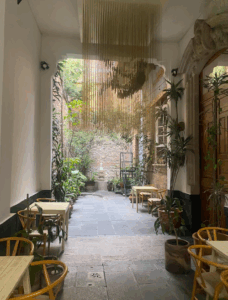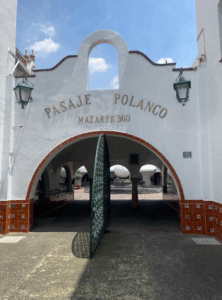The Concrete Hopes Embedded in Creating Circular Cities
Mexico City, Mexico was the 2025 host of the Circular Cities and Policy Summit, making it the first Latin American country to do so in roughly 20 years. Given the prestigious background of Mexico’s president and previous mayor of Mexico City, Presidente Claudia Sheinbaum-Pardo, who has a PhD in Energy Engineering, the choice seems to be an obvious one. What is not as readily seen are the innovative approaches to eco-sustainability that Mexico is investing in.
The city itself is a whirlwind of development, culture and activity. To make a bold statement, I believe we all live in developing worlds and Mexico City is no different. There are areas which are highly developed and curated in a manner similar to the West-side of Los Angeles. Polanco, for example where the conference was held, can boast of a lush central park, shopping mall plazas, luxury brands and green corridors. Along these corridors you’ll find multi-storied apartments with glass walled balconies, chain restaurants and boutique cafes where one can sit and watch the city move around them. Within the same 11 mile radius you can also find large wide paved streets with spotty tree coverage, low power lines intermingled with tree branches, crumbling sidewalks and car-repair shops situated next to small tiendas. Not unlike certain parts of Downtown Los Angeles or even East L.A.. San Rafael was of the latter, where development and traditional living meshed into a network of lively and unpredictable amenities or experiences around every corner.
I chose to stay in San Rafael at a boutique hotel called El Patio 77 because it had a reputation for being eco-friendly. This meant that there was no mini-fridge, central air conditioning or television in the room. Wifi was spotty and there were signs posted advocating for patience when using the shower for hot water and care when flushing the toilet. It also meant a tailored breakfast was provided for free each morning according to guest preference and demand, reducing the waist that continental buffets tend to create. That the room was grand with floor to ceiling windows, real antique wooden furniture, cultural interior design and a balcony that opened up to the city life below. At night there were calls for tamales in the street, and music seemed to play out of nowhere on violin. In the morning, pan dulce and more tamales were on the menu. A stark contrast to the grandeur of the InterContinental Presidente hotel where the conference was hosted.
After what I can only describe as creative traffic navigation in my rideshare, I arrived at a sweeping valet roundabout where an attendee dressed in a full suit with coattails opened my car door. The formal greeting led me to electric doors that opened on sensor and bathed me in a cooled air-conditioned atmosphere. The lobby was twinkling in its refinery, polished, shiny, well lit and glittering. I walked up polished wooden steps to the escalator where I could check into the conference and immerse myself in the world of concrete, cement and the philosophy of circular cities. To say that the conference was fascinating would be an understatement. There were well over 100 CEO’s in the industry in attendance, some as guests and some as speakers for the event.
Cement and Concrete contribute to 8% of the global Carbon Monoxide footprint, and this organization was looking to do something about it. Not only in coming up with creative ways to repurpose Carbon Monoxide output for further manufacturing as was the goal for AGC Carbon Inc, but the reduce the output itself through reuse. The concept of Circular Cities is essentially that we have extracted enough raw material for the foreseeable future, and that we must instead, learn to make use of what we have, build from it and recycle that which would normally be classified as waste. Some of the solutions proposed included separating the rebar wire from demolished concrete building and grinding up the material to reuse in future construction. Cemex is a company that specializes in recycling concrete to help reduce the impact it has on CO2 emissions. Low carbon cement contains a minimum of 25% recycled aggregate concrete, and such a product currently exists in Switzerland called Susteno. Another solution put forth was repurposing building to bypass the full demolition process altogether. A local example is the conversion of the Angel City Brewery which used to be a cable manufacturing warehouse and now is a central fixture in downtown Los Angeles social life. Taking what already exists and retrofitting it into low-income housing or business hubs and community centers can prove to be a lower cost alternative to erecting new housing made from cheaper building materials.
full demolition process altogether. A local example is the conversion of the Angel City Brewery which used to be a cable manufacturing warehouse and now is a central fixture in downtown Los Angeles social life. Taking what already exists and retrofitting it into low-income housing or business hubs and community centers can prove to be a lower cost alternative to erecting new housing made from cheaper building materials.
My favorite speaker, Enrique Norten, Principal and Founder of TEN Arquitectos, touched on the current state of the concrete industry and the need for innovative and creative approaches to architectural design and city development. The construction industry is typically linear; we take resources, make things with them and then discard them into landfills as waste. Implementing a circular approach would mean taking the discards of a development project and deconstructing them into the raw materials needed to use for the construction of new developments. It takes the cycle from take>make>dispose, to make>use>recycle.There are initiatives put forth to enact policy which would require the use of cement products like Susteno, when developing new projects. The goal of the Global Cement and Concrete Association is to reach net zero in CO2 output by 2050. I personally am excited to see this come to fruition.
By Cristy J Portlock





